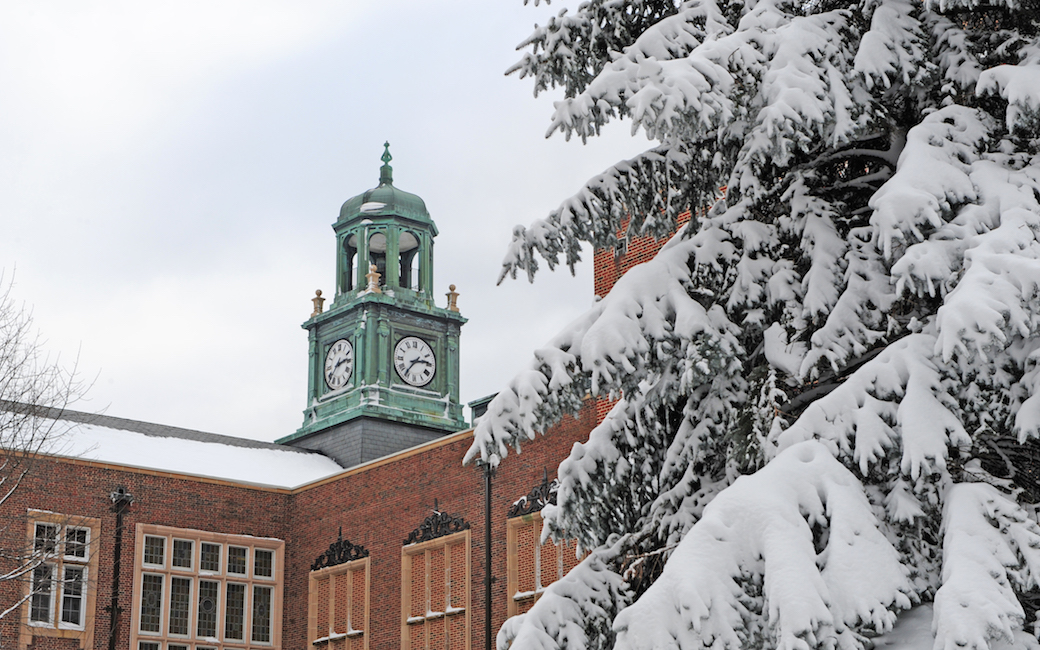The science of snow and when we'll finally see some
TU climatology expert Todd Moore shares his winter weather predictions and busts common cold weather myths
By Rebecca Kirkman on January 10, 2019

An expert in climate change and severe weather climatology, Todd W. Moore moved to Maryland with his family in 2013 after living in Texas for more than three decades.
Not long after arriving at Towson University, he experienced his first Maryland snowfall. “I recall sitting on the porch of the apartment my family was renting at the time and appreciating the almost eerie quiet,” says the assistant professor of geography and environmental planning. “This is something I have grown to love about snowstorms.”
On the heels of the wettest year on record, we asked Moore about what the Baltimore area should expect this winter and to debunk common misconceptions about cold weather.
How is it possible for snow to fall when the temperature is above freezing?
Temperature decreases with altitude through the lower level of the atmosphere, called the troposphere. Snow forms in the higher levels of the troposphere, where the temperature is likely below freezing—especially in winter—even if the temperature at the surface is above freezing. As a flake of snow falls, it will begin melting if the temperature in the lower troposphere is above freezing.

The melting snowflake actually cools the atmosphere immediately around it (because melting and subsequent evaporation consumes energy from the atmosphere and cools it), which is what allows some flakes to reach the ground even if the lower troposphere is above freezing. A dry lower atmosphere, therefore, favors snow when it is above freezing (because more evaporation and cooling of the air immediately around the snowflake will occur).
What impacts the size and shape of snowflakes?
Snowflakes are made of many individual crystals (for example, plates, columns, needles and dendrites). Temperature and humidity are important to the formation of different types of crystals.
Do smaller flakes really mean it’s colder and more likely for snow to stick?
Yes, smaller flakes tend to occur when it is colder, also meaning that the flakes are more likely to stick and accumulate. Bigger flakes form when the atmosphere through which they are falling is warmer (often a little above freezing). These flakes do not tend to accumulate because the temperature is too warm and because they have high liquid water content.
What is a common misconception you’ve heard about snow?
One that I’ve heard is that the ground is too warm for snow to accumulate. Snow can accumulate on surfaces well above freezing, as long as the atmosphere is sufficiently cold and dry to allow the flakes to make it to the surface and as long as snow is falling hard enough.
Is it true that the coldest places get the most snow?
While snow can fall at extremely cold temperatures (well below freezing), storms with a lot of snow are actually less common when it is well below freezing. Snow, and especially heavy snow, requires three basic ingredients: One, a sufficiently cold atmosphere, two, moisture in the atmosphere, and three, rising air. When it is well below freezing, the first ingredient is present, but the second and third ingredients usually are not because a really cold atmosphere is a really dry atmosphere that favors sinking rather than rising motion.
How will climate change impact snowfall?
A misconception is that climate change and a warmer world mean that snow and snowstorms will become less likely. Sure, the global temperature could become so warm that no precipitation falls as snow, but this is highly unlikely to occur anytime soon. In the near future, yes, more precipitation is likely to fall as rain than snow as temperature continues to climb. This, however, does not mean that snowstorms are a thing of the past.
“ Snowstorms are likely to occur—perhaps even record-setting snowstorms. ”
A warmer atmosphere will be more unstable (meaning it has a tendency to rise) and more humid. Recall that these two ingredients favor heavy snow and snowstorms. All that is missing is cold temperature. Cold temperatures will still occur in a warmer world at mid and high latitudes in winter, and when these cold temperatures co-occur with more unstable and humid conditions, snowstorms are likely to occur—perhaps even record-setting snowstorms.
Some have predicted a colder than average winter for the eastern half of the United States. What should we expect in the Baltimore area?
Winter outlooks are largely based on large-scale atmospheric patterns, such as the El Niño/Southern Oscillation. Over time, meteorologists and climatologists have recorded temperature and snowfall amounts during different phases of these patterns. From these datasets, we can get some indication of possible conditions in the upcoming winter.
During the El Niño phase of the El Niño/Southern Oscillation, for example, the winter
temperature in the Mid-Atlantic region tends to be near or slightly below average.
Therefore, we expect the temperature this season to be near or slightly below average
when it’s over, given that an El Niño event is emerging. Snowfall also tends to be
slightly above average during El Niño winters, which is a consideration in some of
the predictions of a snowy winter.
When we take a look at the temperatures from this winter, I expect them to be near
average, but with notable variability—meaning some cold outbreaks and warm outbreaks.
[While the] last part of December [was] slightly above average in temperature, I think
conditions will favor some storms and snow in the latter part of the season (late
January, February and perhaps into March).
You’ve studied urban heat islands, a phenomenon where urban centers record higher temperatures than the surrounding rural areas. How does this impact winter weather?
Yes, the urban heat island is capable of influencing winter weather and snowfall. Simply put, the urban heat island is an island of warmer temperatures in and near cities surrounded by a sea of cooler temperatures in the surrounding suburban and rural areas.
This phenomenon is observed in all seasons, so temperatures tend to be warmer in urban areas during winter. This is a good thing during cold outbreaks when temperatures get dangerously low. The warmer surfaces and air temperatures in urban areas also tend to melt snow cover quicker than in the surrounding suburban and rural areas.